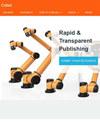Design and optimization of soft colonoscopy robot with variable cross section
引用次数: 0
Abstract
Background Colonoscopy is the best choice for detecting bowel cancer; its effectiveness and early screening can significantly reduce the incidence rate of bowel cancer. However, the existing colonoscopy procedure is very technically demanding for doctors and painful for patients due to the difficult maneuver of long and slender colonoscope inside human colon. This paper will be focused on designing flexible robots with high dexterity to improve the performance of current colonoscopy. Methods This article optimizes and simulates the shape and layout of the driving cavity of the soft robot, as well as the multi-stage structure. This paper presents a design scheme of the soft robot with variable cross-section. The robot comprises two cross-sections in serial connection, with the outer diameter of the upper section 14mm and the outer diameter of the lower part 16mm. The bending angle and direction of the soft robot can be controlled by adjusting the pressure of the cavity. The soft robot is placed at the end of the traditional colonoscopy, replacing the standard manual operation for guidance during colonoscopy surgery. The relationship between the end position of the actuator and air pressure is calculated by the piecewise constant curvature (PCC) method and verified by subsequent experiments. At the same time, the motion trajectory of the soft robot is further simulated by finite element analysis. Results Experimental verification shows that the bending performance of the newly designed soft robot has significantly improved compared to the old design. Conclusion An improvement was made to address the design shortcomings of traditional actuators, and a new actuator was obtained. The performance of the latest and old actuators was compared through experiments, and it was ultimately known that the new actuator had significantly improved performance compared to the old actuator.可变截面软结肠镜检查机器人的设计与优化
背景 结肠镜检查是检测肠癌的最佳选择,其有效性和早期筛查可大大降低肠癌的发病率。然而,由于细长的结肠镜在人体结肠内难以操作,现有的结肠镜检查程序对医生的技术要求很高,对病人来说也很痛苦。本文将专注于设计具有高灵活性的柔性机器人,以改善目前结肠镜检查的性能。方法 本文对软体机器人驱动腔的形状和布局以及多级结构进行了优化和模拟。本文提出了可变截面软机器人的设计方案。该机器人由串联的两个截面组成,上部的外径为 14 毫米,下部的外径为 16 毫米。软体机器人的弯曲角度和方向可通过调节腔体压力来控制。软机器人被放置在传统结肠镜检查的末端,取代了结肠镜手术中标准的人工操作引导。通过片断恒定曲率(PCC)方法计算出执行器末端位置与气压之间的关系,并通过随后的实验进行了验证。同时,通过有限元分析进一步模拟了软体机器人的运动轨迹。结果 实验验证表明,与旧设计相比,新设计的软体机器人的弯曲性能有了明显改善。结论 针对传统致动器的设计缺陷进行了改进,得到了一种新型致动器。通过实验比较了最新致动器和旧致动器的性能,最终得知新致动器的性能比旧致动器有了显著提高。
本文章由计算机程序翻译,如有差异,请以英文原文为准。
求助全文
约1分钟内获得全文
求助全文
来源期刊

Cobot
collaborative robots-
自引率
0.00%
发文量
0
期刊介绍:
Cobot is a rapid multidisciplinary open access publishing platform for research focused on the interdisciplinary field of collaborative robots. The aim of Cobot is to enhance knowledge and share the results of the latest innovative technologies for the technicians, researchers and experts engaged in collaborative robot research. The platform will welcome submissions in all areas of scientific and technical research related to collaborative robots, and all articles will benefit from open peer review.
The scope of Cobot includes, but is not limited to:
● Intelligent robots
● Artificial intelligence
● Human-machine collaboration and integration
● Machine vision
● Intelligent sensing
● Smart materials
● Design, development and testing of collaborative robots
● Software for cobots
● Industrial applications of cobots
● Service applications of cobots
● Medical and health applications of cobots
● Educational applications of cobots
As well as research articles and case studies, Cobot accepts a variety of article types including method articles, study protocols, software tools, systematic reviews, data notes, brief reports, and opinion articles.
 求助内容:
求助内容: 应助结果提醒方式:
应助结果提醒方式:


